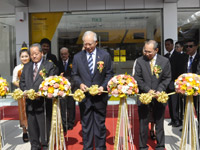Central bank: Microfinance units should issue loans for education, poverty reduction
Central bank: Microfinance units should issue loans for education, poverty reduction
The Bank of the Lao PDR has directed microfinance inst itutions to increase loans for education in remote communities for the purposes of human resource development and poverty reduction.
If people in rural communities have access to improved education, they will have a better quality of life, Deputy Governor of the Bank of the Lao PDR, Mr Sonsay Sithphasay, said at the microfinance stakeholder forum in Vientiane yesterday.
Many children in rural areas lack access to education because of insufficient funding.
The Bank of the Lao PDR is the central bank and, as a government agency, formulates plans and implements projects to fulfil the national socio-economic development plan. The bank provides facilities and development access to people in remote areas as well as to poor and disadvantaged families.
The rural finance and microfinance sector is an important tool in the government's poverty reduction plan, in cooperation with the Bank of the Lao PDR and various domestic and international organisations.
Currently there are 56 microfinance institutions under the Bank of the Lao PDR, of which 13 are deposit taking entities, 19 are non-deposit taking, and 20 are savings and credit unions. There are more in each category this year than last.
Nine months after implementation of the microfinance policy, bank reports show that savings and credit have increased.
Profit from the microfinance sector has risen by 27 percent, total available assets have increased by 66 percent, and about 18,500 new depositors have come forward.
Loans were provided to three sectors. Private businesses comprised 67 percent of gross credit, 15 percent went to agriculture and livestock, and 18 percent went towards handicrafts and the improvement of living conditions.
Microfinance institutions still have many problems to solve such as policy implementation, legislation, and the acquisition of adequate office equipment.
Some institutions still lack understanding of the rules and principles and have limited administration skills.
To develop microfinance in Laos, responsibility and competition should be increased, rather than merely waiting for government assistance. Instead, institutions should actively try to obtain more customers.
To promote financial services among the public and to better regulate financial institutions in Laos, the central bank has established various service units such as pawnshops, leasing companies and money transfer agencies.
Yesterday's meeting also discussed next year's plan for improving microfinance institutions and providing more services for people in rural communities.
vientiane times















